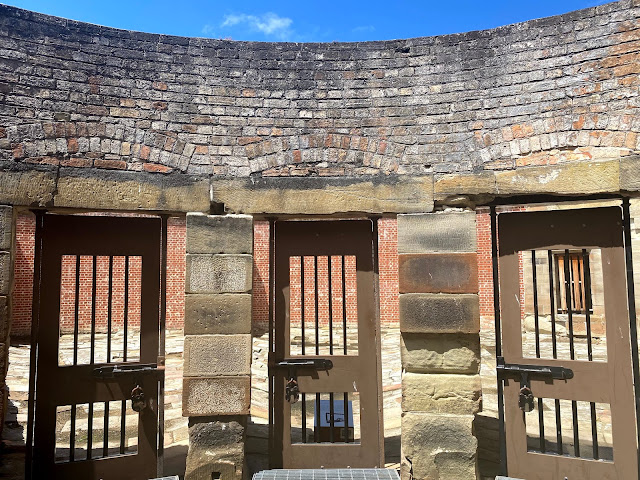After the Revolutionary war, Britain could no longer send criminals to the Americas. So beginning in 1830, criminals were shipped to Port Arthur. The majority were petty criminals from London, Birmingham, and Manchester, cities overwhelmed by the Industrial revolution, as hungry displaced workers swarmed to the cities, where there were few jobs. As you walk the grounds, you learn the stories of many of these men. Typical crimes: stealing, arguments, forgery, crimes of poverty.
Prisoners at Port Arthur were contracted laborers. The main building below was originally a granary. Later it was converted to a dormitory. At its peak, Port Arthur housed 2000 men. Many were contracted to local landowners to cut down trees and build ships and pay back their debts.
Prisoners arrived at Port Arthur by sea, traveling for months from Europe. There were no roads. A sailboat could make it from Hobart in 8–12 hours.
This is Point Puer, the first British prison for adolescents, separated from the main prison on an island in the bay. Boys as young as 9 were shipped around the world, many teen-aged gang members with a long history of stealing to survive. Here they were fed, educated, and taught trades—it was prison, far from idyllic. But ironically this greatly increased their life expectancy compared to staying in London in squalor.
The remains of the legal courts, bricks made by prisoners. Driving here, I passed bricks for sale by the side of the road, 50¢ each.
Port Arthur is a beautiful place when the sun breaks through the clouds. It's a remote, heavily wooded peninsula. Even if prisoners escaped, they were typically recaptured months later. There was nowhere for them to go.
The sunny asylum, a relative haven at Port Arthur, is now a museum and cafe with the so-called separate prison aka solitary to its right.
In the separate prison, men were kept in cells in silence 23 hours a day. This was done in lieu of physical torture, but not surprisingly turned out to have devastating long-term effects.
If this diagram looks familiar, it's the design of philosopher Jeremy Bentham's panopticon with central surveillance. (The title of this post is also Bentham.)
Port Arthur was considered progressive for its time, with dual goals of punishing prisoners and reforming them. They were "inspired" by the prison system in Pennsylvania. Port Arthur had an extensive prison library of 13,000 books, which no doubt provided some solace for those isolated from the rest of the world and society. Many of the books were religious, but not all. Those in separate prison were still expected to work in their cells; some made shoes or performed other crafts like wood turning.
Separate exercise areas and separate pews, with walls separating prisoners so they could not look at each other.
Prisoners were taken out in hoods covering their faces, further dehumanizing them.
The British kept extensive records, and "experts" from priests to psychologists testified about the effects of solitary on prisoners young and old. By 1853, prisoners were no longer being sent to Tasmania. In later years, the grounds were maintained to care for for elderly former prisoners who could no longer work.
The boys on Point Puer did much of the stonework.
By contrast, the hundreds of officers stationed at Port Arthur and the surgeons and priests lived in small cottages. Their wives tended flowers and some taught school.
When you're in the gardens, it's easy to forget you're on the grounds of a prison. And yet...and yet. Prisoners who weren't strong enough for manual labor grew vegetables in the gardens, but were not allowed to eat them.
Port Arthur closed as a prison in the 1870s. The grounds were sold. The commandant's house was turned into a hotel. Bricks were sent to Hobart. Fire destroyed many of the buildings.
Over the years visitors have stolen keepsakes from Port Arthur. A few had second thoughts. This reminded me of the museum at the Painted Desert, where rangers ask if you have taken any rocks. People return them years later with notes about how they lied and their lives have been cursed ever since.
Invoking the ghost of pastor George on the ghost tour
Are there ghosts at Port Arthur? Hard to imagine there aren't.
***
In modern times, Port Arthur is remembered as the site of Australia's worst gun massacre. On April 28, 1996, a man opened fire with a machine gun and killed 35 people and wounded 23. This garden is a place of remembrance.
The murderer was given 35 consecutive life sentences. His name is not noted here, just the many lives he cut short.
Australia did what the US has refused to do in the wake of repeated tragic mass shootings: it banned semi-automatic weapons. It set up buybacks. It heavily restricted civilian ownership of weapons. And it's worked. Australia has one of the lowest rates of gun deaths in the world. Suicides plummeted.
On this 7th anniversary of the Sandy Hook massacre, we should learn from the past and follow their example. And break the cycle of violence for good.























My day isn't complete, without going through your posts.
ReplyDeleteThey make me reflect on what we have in common with the distant past,
and in the way of opportunities yet taken up.